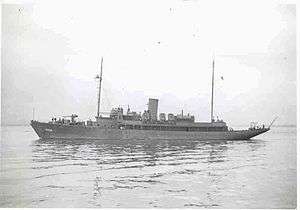USS Argus (PY-14)
 USS Argus (PY-14), at sea, circa 1944/1945. | |
| History | |
|---|---|
| Name: | Haida |
| Namesake: | Haida people |
| Builder: | Germaniawerft, Kiel |
| Completed: | 1929 |
| Status: | Acquired by the Navy, 25 October 1940 |
| History | |
| Name: | Argus |
| Namesake: | Argus Panoptes |
| Acquired: | 25 October 1940 |
| Commissioned: | 13 February 1941 |
| Decommissioned: | 15 April 1946 |
| Struck: | 21 May 1946 |
| Identification: |
|
| Fate: | Sold into private market |
| Status: | Transferred to the Maritime Commission, 30 October 1946 |
| General characteristics | |
| Type: | Yacht |
| Displacement: | 859 long tons (873 t) |
| Length: | 207 ft 6 in (63.25 m) |
| Beam: | 30 ft (9.1 m) |
| Draft: | 13 ft 5 in (4.09 m) |
| Installed power: |
|
| Propulsion: | 2 × screws |
| Speed: | 13.5 kn (15.5 mph; 25.0 km/h) |
| Complement: | 59 |
| Armament: |
|
USS Argus (PY-14) was a patrol yacht that saw service in the United States Navy during World War II. Named for the Argus (a monster with a hundred eyes supposedly slain by the Greek mythological messenger of the gods, Hermes), she was the second U.S. Navy vessel to bear the name.
Construction, acquisition, and commissioning
A yacht built in 1929 at Kiel, Germany by Germaniawerft as Haida, the ship was acquired by the Navy on 25 October 1940 from Mrs. Max C. Fleischmann of Glenbrook, Nevada; converted at Long Beach, California by the Craig Shipbuilding Company for naval service; renamed Argus on 14 November 1940; and commissioned on 13 February 1941 with Lieutenant Commander Harold H. Connelley in command.[1]
US Navy service history
Argus arrived in San Francisco on 19 February 1941 and began duty patrolling San Francisco Bay as a unit of the Patrol force, 12th Naval District. That assignment lasted until May 1941, when she was reassigned to what appears to have been a successor organization — Patrol Squadron 1, Local Defense Force, 12th Naval District. Her duty, however, remained substantially the same as before, patrolling San Francisco Bay. She continued to perform this task until decommissioned on 17 September. She was then transferred to the United States Coast and Geodetic Survey.[1]
United States Coast and Geodetic Survey career
Renamed Pioneer, she served the United States Coast and Geodetic Survey for eight months before she was returned to the United States Navy in March 1942.
Return to Navy service
Pioneer was returned to the Navy on 16 March 1942 and, after reconversion at the General Engineering & Drydock Company, she was recommissioned at San Francisco on 18 April, again as Argus. The converted yacht resumed her patrols of San Francisco Bay under the auspices of the Commandant, 12th Naval District, and continued that duty for the remainder of her naval career. There were two notable events during her wartime career. The first occurred when Argus rescued the 60 survivors from the Liberty ship John A. Johnson, which had been torpedoed and sunk by the I-12 on 30 October 1944. I-12, after ramming and sinking the lifeboats and rafts, had then machine-gunned the 70 survivors in the water, killing 10. A Pan American Airways plane spotted John A. Johnson's remaining men soon thereafter, and Argus recovered them at 21:35 on 30 October. She disembarked them at San Francisco on 3 November. Ardent and Rockford then teamed up to sink I-12 10 days later.[1]
In the second event, Argus participated in the establishment of a weather station on Clipperton Island, 670 mi (1,080 km) southwest of Acapulco, Mexico. Departing San Francisco on 4 December 1944 with meteorological personnel embarked, the converted yacht reached the island a week later and landed her passengers. With the American colors hoisted over the island, the naval weather station was set up that day, supported at the outset by Argus. The yacht was decommissioned at San Francisco on 15 April 1946. Her name was struck from the Naval Vessel Register on 21 May, and she was transferred to the Maritime Commission on 30 October for disposal.[1]
Return to yacht service
The ship was sold in late 1946 and renamed Sarina. Owners included Egyptian cotton magnate Maurice Ada, American industrialist Larry Green, British Member of Parliament Loel Guinness, and film producer Robert Stigwood.
Sarina was renamed Rosenkavalier in 1981 by a Greek owner, possibly Stanley Steeger; sold again to the Isaka family of Yokohama in 1988, and returned to Greek ownership in 1992.
In 1999 a new owner refurbished and renamed her Haida G. She has been restored to her original condition, including a refit of the original main engines and is still in commercial service.
See also
References
- 1 2 3 4 "Argus II (PY-14)". Naval History and Heritage Command. Retrieved 29 January 2016.
- This article incorporates text from the public domain Dictionary of American Naval Fighting Ships. The entry can be found here.
- "Argus". Dictionary of American Naval Fighting Ships. Retrieved 28 June 2007.
- "Special Report: Haida G celebrates her 80th year". Superyacht Times. Retrieved 15 July 2011.
External links
| Wikimedia Commons has media related to USS Argus (PY-14). |
Photo gallery of USS Argus (PY-14) at NavSource Naval History